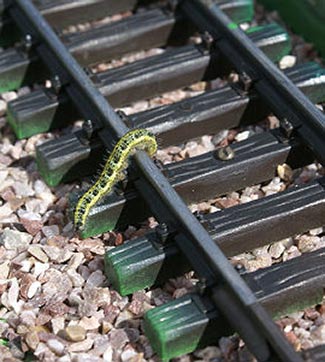Chinese caterpillars stop a train. Australian camels are adding to climate warming. These are some of the more unusual news snippets available on “Earthweek – A Diary of the Planet: Weekly News” that is featured on our web site as part of “Earth Gate” which includes a weekly environmental news map and short descriptions of major events occurring around the world:
Caterpillars Bring China Train to a Standstill
A Chinese freight train was slimed to a halt when it encountered an untold number of caterpillars crawling across the tracks. The China Daily reports the insects were spread out over more than one-half mile of track in an Inner Mongolia valley, probably trying to cross the rails in search of food. Once crushed, they made the tracks too slick for the train to maintain traction.
Railway officer Fu Jianguo said the train was able to resume its journey three hours later after about a dozen workers cleaned the tracks with brooms and shovels. “I’ve heard of caterpillars causing short circuits or stopping trains before, but have never actually seen such a thing,” he told the paper. Jiangou added that the insects had just ravaged the leaves of apricot trees in an adjacent orchard and were moving across the rails in search of more spoils.
Australian Camels to Become Cap-and-Trade Victims
Australian officials are proposing a scheme that could help eliminate non-native camels that have ravaged the country’s northern habitats, while at the same time helping hunters earn cash for killing the greenhouse gas-belching invaders. Australia’s estimated 1.2 million camels comprise the world’s largest wild camel population. They were imported, mainly from India, between 1840 and 1907 to provide European settlers access to arid areas of central and western Australia.
Each camel belches enough methane every year to equal the climate-warming effects of one metric ton of carbon dioxide. A new bill would create a carbon credit system that would pay for each camel slaughtered with funds given by industrial polluters to offset their own carbon emissions. Mark Dreyfus, the government’s parliamentary secretary for climate change, said he hopes the proposal finally wipes out camels from the Australian wild. The animals compete with sheep and cattle for food and water, trample vegetation, and sometimes invade remote communities in search of water.

.jpg)


